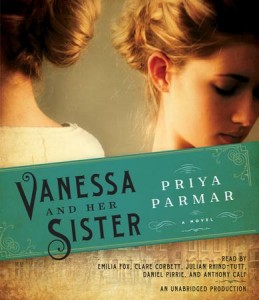Virginia Woolf and the Bloomsbury bohemians are a well-known part of our literary heritage. Even those of us who haven’t really studied them have heard a lot about them. But Virginia, her sister Vanessa and their friends and family come alive in a new way in this highly entertaining and intelligent novel. The audio version is a delight, especially for Anglophiles, and I have no doubt that reading the printed volume would also be a worthwhile pleasure.
VANESSA AND HER SISTER. By Priya Parmar. Read by Emilia Fox, Clare Corbett, Julian Rhind-Tutt, Daniel Pirrie and Anthony Calf. Random House Audio. 11 hours; 9 CDs. $40. Also available in print from Ballantine Books.
 There is no shortage of reading material about the members of the Bloomsbury group, those intellectual and artistic men and women who gathered frequently in the early decades of the 20th century to discuss arts and ideas and live what they viewed as a modern life. Many of them wrote books. They kept journals. They wrote letters. Books have been written about them.
There is no shortage of reading material about the members of the Bloomsbury group, those intellectual and artistic men and women who gathered frequently in the early decades of the 20th century to discuss arts and ideas and live what they viewed as a modern life. Many of them wrote books. They kept journals. They wrote letters. Books have been written about them.
So, one might ask, what’s the point of Priya Parmar’s new novel about the women at the heart of the group, the Stephen sisters – the artist Vanessa Bell and the writer Virginia Woolf?
The answer is that this book is a brilliant and beautifully written work that deftly blends imagination with known fact. Drawing on a few years in the fascinating and well-documented story of these remarkable people, Parmar creates a novel about love, family, art, artists and the risks inherent in freedom.
In an interesting and fairly extensive afterword, Parmar points out the historical truth of some of the more outrageous events and behaviors she describes in the novel. She also gives some insight into what became of various members of the group in later years.
She tells us that unlike many of her friends, Vanessa did not keep a journal. And that is where Parmar’s informed imagination soars. The novel includes letters written by various Bloomsburyites, including Virginia. But its heart consists of the journal entries that Parmar creates for Vanessa.
This book, starting in 1905, focuses on the early years when the group was Adrian – are young adults whose parents are dead. They decide to leave the family home in a more staid section of London and rent a house together in the Bloomsbury district. Young people, especially young men who are friends of the brothers’ from Cambridge, gravitate to the house.
It’s the Edwardian era, before World War I wrought so much change in English society. The Stephens and their friends are wealthy enough to indulge their interests in the arts without earning a living, to take extensive jaunts abroad and to spend a month or so at the shore. One of their elder half-brothers stops by every now and then to disapprove, but otherwise they are free to shed confining social restrictions.
With their parents and older half-sister dead, Vanessa has become the rock that holds the family together. Virginia, always moody and demanding, already has suffered mental and emotional breakdowns. Vanessa, knowing the signs of her younger sister’s incipient madness, caters to her constant hunger for attention and affirmation.
Despite the shadow of Virginia’s fragility, the early months in Bloomsbury seem charmed. Fascinating people come to the house almost nightly to socialize and discuss the latest topics. Despite the late nights, Virginia, Vanessa and their friends manage to find time to pursue their artistic and intellectual endeavors. These years before World War I are heady times for these young and gifted people who have a great deal of freedom. Vanessa’s journals about her painting and her artistic vision are especially fascinating.
But life – illness, tragedy – intervenes. And then Vanessa, heading into her late 20s, agrees to marry Clive Bell, an art critic who is part of the circle of friends.
Vanessa finds unexpected happiness in marriage and especially in motherhood. But Virginia cannot accept what she views as her sister’s desertion, and jealousy and temptation take their toll. Some things, we see, once done cannot be undone.
Readers see what happens mostly through Vanessa’s frank accounts in her journals, but also through occasional letters from perceptive friends.
Eventually Vanessa wonders if too much freedom is as desirable as it seems, and poignantly asks what she and her young contemporaries really were asking for when they defied societal conventions about marriage and other relationships.
The audio version of this book is a gem, read beautifully by a cast of characters. Emilia Fox as Vanessa has the starring role, and the voices of Virginia, Lytton Strachey, Leonard Woolf and Roger Fry enrich the experience.